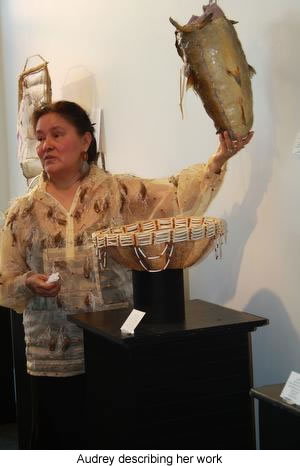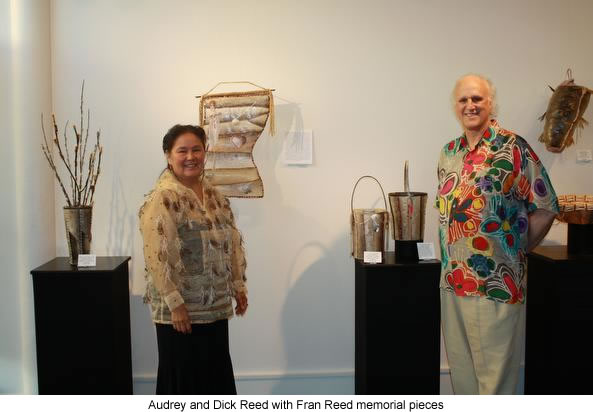 |
Canku Ota
|
 |
|
(Many Paths)
|
||
|
An Online Newsletter
Celebrating Native America
|
||
|
June 1, 2009 - Volume
7 Number 6
|
||
|
|
||
|
Sculpting in Salmon
Skin
|
||
|
by Mike Dunham - Anchorage
Daily News
|
||
|
credits: photos couresy
of the Alaska Native Arts Foundation
|
|
Athabascan
people once made containers by sewing fish skins together. But by
the time Armstrong was born few remembered the skill. Her aunt,
Huslia elder Catherine Attla, recalled hearing about such items
but could not recall having seen them, she said. Orphaned at 6, Armstrong and three siblings were adopted by Harry and Rose Ambrose who, alarmed at how much the children had forgotten while in a Fairbanks orphanage, pulled them out of school and moved into the Kaiyuh Mountains, 90 miles away from the nearest village, to reteach them Athabascan ways and language. Little Audrey furiously resisted one important life skill - sewing. "I hated it!" she said, along with other indoor chores. She preferred to be out on the land with her father and brothers. Her mother finally relented and let the girl go outside to play and work with the boys. She was 28 when the sewing bug bit. She studied under Gwich'in elder Charlotte Douthit and became passionate about traditional skin sewing and bead working. "From then on I loved sewing," she said. "It's my therapy." Another passion struck in 1995, when she fished with a rod and reel for the first time. "I was like in heaven." Now she camps out at one of her favorite fishing spots every weekend during fishing season. "I can stand in the water 10 hours a day." On Sept. 4, 2002, she'd just landed a late run salmon. "I held the salmon up and the sun caught the beautiful rainbow of colors of the fish skin," she wrote. "I knew then that I just had to create something out of this." Her first attempt - on display at her current show at the Alaska Native Arts Foundation Gallery, 500 Sixth Ave. - was a small and clumsily glued cup. For her second try, she used crude stitches. At each step she learned something new and, less than a year later, one of her fish skin baskets won the first place divisional prize for Alaska Native arts at the Anchorage Fur Rendezvous Craft Show. Armstrong, who now lives in Anchorage, found a mentor in the late Fran Reed. Reed, a non-Native, had learned about fish skin baskets from Athabascan elders in Fairbanks and took the craft into the realm of fine art. By the time she died, Sept. 11, 2008, Reed had an international reputation and a resume filled with awards. Armstrong was among a small group of women who took part in Reed's final workshop, conducted last summer at Kasitsna Bay near Seldovia. "The most uplifting, spiritual and awesome class I have ever taken," Armstrong said. "She showed us how to make an old style Athabascan waterproof bag." Reed died of cancer before she could present a paper on fish skin garments at a symposium held by the Textile Society of America, a organization of leading fiber artists and experts. Her husband, Dick, was asked to help find a replacement. "Audrey was getting a lot of inspiration from Fran for the previous five years," he said. "Of the women at that last workshop, all accomplished artists, Audrey was the single most advanced student in fish skin basket making. Fran passed the baton on to Audrey at that workshop." When the time came to give the paper, it was Armstrong who presented it, "and she did a wonderful job," Dick Reed said. Since then offers have poured in. Along with the other women who took part in Reed's last workshop, she'll have work at a show at Homer's Bunnell Arts Center in June titled "Skin Sisters." In July she'll teach her own class in fish skin sewing, again at Kasitsna Bay, then another class in Mendocino, Calif., and next year in New Zealand. While Reed's work could be abstract - "artistic" as Armstrong says - her own pieces have tended to reflect the practical origins of the craft, bowls, baskets and such. Yet they all have the look of sculpture. Armstrong's new work on display at the Alaska Native Arts Foundation Gallery shows Reed's knack for adornment, with leather, shells, feathers, stones, beads and designs worked into the basic forms, all intended to convey additional layers of meaning. The grand "Chief's bowl," for example, which took her three months to complete, uses king salmon skin, "because salmon is the richest fish," and a dentalium shell necklace, symbol of power and wealth among pre-contact Athabascans. "One shell could be traded for three beaver pelts," Armstrong said. "So you can see how valuable they were."
Then there's a wall hanging titled "Fran's Embodiment." It began as a series of strips, but took on a wave form that suggest a human torso. Armstrong included heart shapes - "My heart to her heart" - and flowers and dentalium, "signifying her leadership as a teacher. She really preserved this art for us." Armstrong's own baskets are now in the collections of the Alaska Federation of Natives, Cook Inlet Regional Incorporated, Alaska Native Tribal Health Consortium, Alaska Native Medical Center and private collections around the nation. Her individual pieces are often sold at Alaska Native Arts Foundation Gallery and the Alaska Native Medical Center. You can find her at a local salmon stream when the fish are running. Look for the sign that says, "Free filleting if you let us keep your skins." (Enough people don't like to clean their own fish that the advertising works, she said.) Or she can be reached at audreyarm@gci.net. However, she's usually backed up with special orders, she said. The exhibit now at Alaska Native Arts Foundation Gallery was made possible in part by an Individual Artist award from the Rasmuson Foundation. "I'm 61 and finally having my first solo art show," said Armstrong, who recently retired from the medical profession after 35 years in various office and administrative positions. "It's hard to believe." No one is more surprised than Rose Ambrose who had her first chance to see her daughter's work on a recent trip to Anchorage. Amazed and chuckling at the same time, she said, "What happened to this little girl who hated to sew? Now look! Look at all the sewing!" |
|
|
||
|
|
||
| Canku Ota is a free Newsletter celebrating Native America, its traditions and accomplishments . We do not provide subscriber or visitor names to anyone. Some articles presented in Canku Ota may contain copyright material. We have received appropriate permissions for republishing any articles. Material appearing here is distributed without profit or monetary gain to those who have expressed an interest. This is in accordance with Title 17 U.S.C. Section 107. | ||
|
Canku Ota is a copyright ©
2000, 2001, 2002, 2003, 2004, 2005, 2006, 2007, 2008, 2009 of Vicki
Barry and Paul Barry.
|
||
 |
 |
|
|
The "Canku
Ota - A Newsletter Celebrating Native America" web site and
its design is the
|
||
|
Copyright ©
1999, 2000, 2001, 2002, 2003, 2004, 2005,
2006, 2007, 2008 of Paul C.
Barry.
|
||
|
All Rights Reserved.
|
||
 ANCHORAGE,
Alaska — 'I don't like to waste anything," said Audrey
Armstrong. That includes what some would consider garbage. She pointed
to a beautifully formed bowl made from reddish salmon skins. "Those
are the leftovers from four of my girlfriends' dinners."
ANCHORAGE,
Alaska — 'I don't like to waste anything," said Audrey
Armstrong. That includes what some would consider garbage. She pointed
to a beautifully formed bowl made from reddish salmon skins. "Those
are the leftovers from four of my girlfriends' dinners." A
couple of the pieces are tributes to Reed, including a berry basket
decorated with bright beads, a nod to the "Happy Life Club"
- Reed's friends who dressed in colorful costumes for parties to
boost her spirits during her final illness. "I call it 'Fran's
Gathering Basket,'" Armstrong said. "She had a special
way of bringing people into her life and bringing people together."
A
couple of the pieces are tributes to Reed, including a berry basket
decorated with bright beads, a nod to the "Happy Life Club"
- Reed's friends who dressed in colorful costumes for parties to
boost her spirits during her final illness. "I call it 'Fran's
Gathering Basket,'" Armstrong said. "She had a special
way of bringing people into her life and bringing people together."